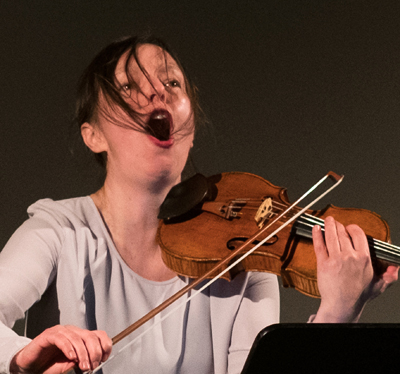In Embodying Expression, Gender, Charisma – Breaking Boundaries of Classical Instrumental Practices (EmEGC), performer and artistic researcher Prof Dr Barbara Lüneburg (PI), sociologist Dr Kai Ginkel (post-doc), and performer and artistic researcher Renata Kambarova (pre-doc) explore the role of a performer’s body as a determining factor in musical expression, gender and charisma, and investigate how it manifests in and through the body.
The research moves from Western classical instrumental concert practice, incorporating performances from classical to contemporary music into its investigation, and translates the research findings into artworks for a multimodal exhibition and performance for violin and multimedia. In a dual research design, methods of artistic research, including performance and creation, will be brought together with methods and theories of sociology of practices.
Including three generations of artists/researchers in the project, working interdisciplinarily with a scholar from sociology of practice, opening the discourse to a diverse corpus of guest artists and the public, and exploring our topic in workshops with students from different instrumental and socio-cultural backgrounds, ensures a multiplicity of perspectives on our topic. This inclusive approach will be treated as a pivotal dynamic through which understanding and change will be brought forward.

The body is the medium through which instrumentalists realize sound, musical ideas, and emotion. Their body, simultaneously, is the emotion, and the conveyer of sound and musical idea.
Performers use – consciously or unconsciously – gestures and facial expression as well as the staging of the body as a means of expression, communication, and interaction with the audience. Through their corporeality they allow the audience insight into their individual but also staged and culturally shaped personalities.
The audience in turn perceives and interprets performers through their body language as much as through the sounding, musical expression. Psychologist Jane Davidson reports that “the body movements of the performers inform the audience about their musical intention”, and further suggests that “in live or video performance viewing, audiences can enhance their understanding of a musical performance by observing the performer’s movements”. (Davidson 1997, 222 f.)
Embodiment plays directly into or even constructs the value system that is shared with the audience because bodily and artistic expression are intertwined with social messages and meanings. In gestures emotions and thought processes are produced and represented.
We understand a performer’s ‘embodiment’ as technique and habit inscribed in their body through training, years of practice, cultural association, lived values, and individual personality. We consider it an essential part of musical and gender expression, and in that it becomes part of the charisma that is co-constructed with the audience. We tie together body and mind, music and situatedness, the fluidity of genderedness, and charisma, and investigate how liberating a performer from pre-conceived values and learned habits “directly influences the performers’ creative strategies and goals, musical objectives, and capacity to share their artistic experiences with the audience.” (Ciciliani, Lüneburg, Pichner 2021, 98).

Embodying Expression, Gender Charisma is funded by the Austrian Science Fund FWF as project PEEK AR 749-G and is located at the Anton Bruckner Private University in Austria. The project has a runtime of forty months starting in August 2022.